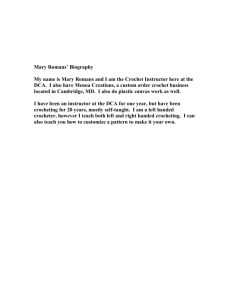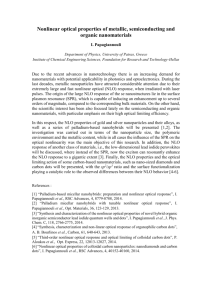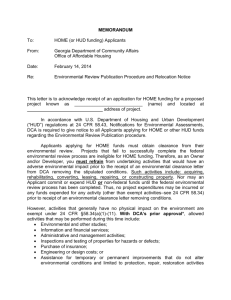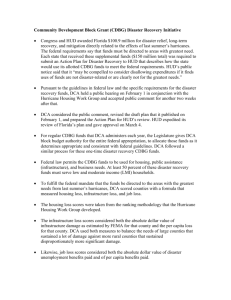Recent Progress in Non-linear Optical Material, Syntheses
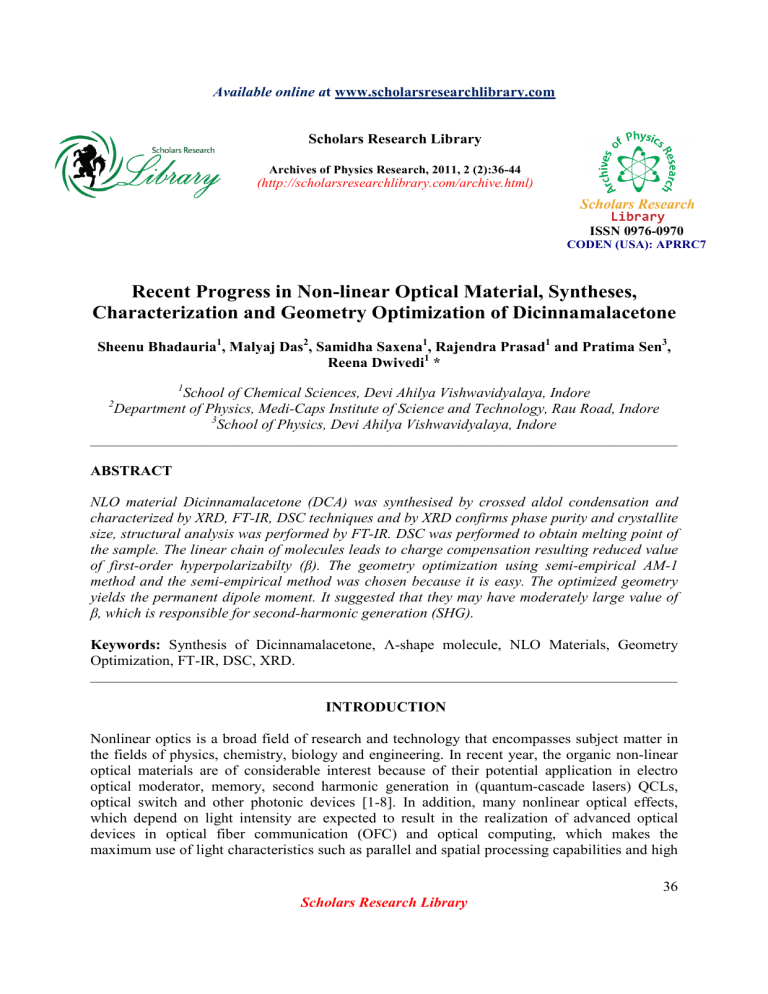
Available online at www.scholarsresearchlibrary.com
Scholars Research Library
Archives of Physics Research, 2011, 2 (2):36-44
(http://scholarsresearchlibrary.com/archive.html)
ISSN 0976-0970
CODEN (USA): APRRC7
Recent Progress in Non-linear Optical Material, Syntheses,
Characterization and Geometry Optimization of Dicinnamalacetone
Sheenu Bhadauria
1
, Malyaj Das
2
, Samidha Saxena
1
, Rajendra Prasad
1
and Pratima Sen
3
,
Reena Dwivedi
1
*
1
School of Chemical Sciences, Devi Ahilya Vishwavidyalaya, Indore
2
Department of Physics, Medi-Caps Institute of Science and Technology, Rau Road, Indore
3
School of Physics, Devi Ahilya Vishwavidyalaya, Indore
_____________________________________________________________________________________
ABSTRACT
NLO material Dicinnamalacetone (DCA) was synthesised by crossed aldol condensation and characterized by XRD, FT-IR, DSC techniques and by XRD confirms phase purity and crystallite size, structural analysis was performed by FT-IR. DSC was performed to obtain melting point of the sample. The linear chain of molecules leads to charge compensation resulting reduced value of first-order hyperpolarizabilty ( β ). The geometry optimization using semi-empirical AM-1 method and the semi-empirical method was chosen because it is easy. The optimized geometry yields the permanent dipole moment. It suggested that they may have moderately large value of
β , which is responsible for second-harmonic generation (SHG).
Keywords: Synthesis of Dicinnamalacetone, Λ -shape molecule, NLO Materials, Geometry
Optimization, FT-IR, DSC, XRD.
_____________________________________________________________________________________
INTRODUCTION
Nonlinear optics is a broad field of research and technology that encompasses subject matter in the fields of physics, chemistry, biology and engineering. In recent year, the organic non-linear optical materials are of considerable interest because of their potential application in electro optical moderator, memory, second harmonic generation in (quantum-cascade lasers) QCLs, optical switch and other photonic devices [1-8]. In addition, many nonlinear optical effects, which depend on light intensity are expected to result in the realization of advanced optical devices in optical fiber communication (OFC) and optical computing, which makes the maximum use of light characteristics such as parallel and spatial processing capabilities and high
36
Scholars Research Library
Reena Dwivedi et al Arch. Phy. Res., 2011, 2 (2):36-44
______________________________________________________________________________ speed. Using organic molecules for the nonlinear media has several advantages, such as low cost, low dielectric constant and great diversity of possible organic structures (Keinan S. et al., 2004).
The search for new NLO materials has been increasing as a result of growing demand for such materials [9]. Among NLO materials, organic materials are of special interest because the nonlinear optical response in this broad class of materials is microscopic in origin, offering an opportunity to use theoretical modeling coupled with synthetic flexibility to design and produce novel materials [10]. Also, one of the advantages in working with organic materials is that they allow one to fine-tune the chemical structures and properties for the desired nonlinear optical properties. In addition, they have large structural diversity. The properties of organic compounds can be refined using molecular engineering and chemical synthesis [11].
To the best of our knowledge, there is no report on the structure elucidation and NLO properties of DCA. The present problem therefore to undertake with a view (i) to get optimized structure of
DCA employing semi-empirical molecular orbital method and (ii) to investigate the NLO behaviour of this molecule to conform its structure. Materials possessing NLO properties change the propagation characteristics (phase, frequency, amplitude, polarization, etc.) of the incident light.
MATERIALS AND METHODS
Synthesis of Dicinnamalacetone
Material used in syntheses of DCA are Cinnamaldehyde, Acetone, Ethanol, Acetic acid, Sodium hydroxide were procured from m/s Merck. Place 2 ml Cinnamaldehyde and 10 ml ethanol in a
100 ml Erlenmeyer flask. Add 7 ml (2M) NaOH and swirl to mixture pH will be basic. Add 2.5 ml acetone via micro syringe and swirl the mixture vigorously until precipitation is complete.
Cool the reaction mixture in an ice bath for 15-20 minute. To ensure complete crystallization collect the crystals by vacuum filtration and rinse the crystal with 3-4 small portion of ice cold ethanol. Rinse the crystals of small portion of 10 % acetic acid to neutralize excess base, then rinse again with ice cold ethanol.
Different characterization techniques used for sample
DCA were characterized using X-ray diffraction studies (Rigaku, CuK α radiation) and FT-IR spectroscopy, Bruker VERTEX 70, DSC was performed with instrument 2910 MDSC. NLO property of the crystal was confirmed by Kurtz powder technique using 15 ns pulsed Nd: YAG
Laser at 1064 nm wavelength, geometry was optimized by Hyperchem Software using semiempirical Austin Model 1 (AM-1) method.
RESULTS AND DISCUSSION
DCA is yellow crystalline solid and are stable at room temperature. It is insoluble in water and soluble in common organic solvents such as methanol, ethanol, benzene and dicholoro methane at room temperature. A crossed aldol condensation is an aldol condensation in which one aldehyde or ketone adds to the carbonyl group of a different compound. The compound used in a crossed aldol condensation must be carefully selected to avoid unwanted product mixtures.
Crossed aldol condensation is most effective if only one of the reactant form enolate ion and the other reactant is particularly electrophilic towards enolates. Cinnamaldehyde is an excellent
37
Scholars Research Library
Reena Dwivedi et al Arch. Phy. Res., 2011, 2 (2):36-44
______________________________________________________________________________ reagent for the crossed aldol condensation because it has no alpha hydrogen, so it can’t form an enolate the base catalyses cinnamaldehyde with acetone is shown in Scheme 1 and formation of
DCA mechanism in Scheme 1.
FT-IR spectral studies
Fourier transfer infrared (FT-IR) spectra were recorded at room temperature in the range of
4000- 400 cm
−1
as KBr pellets using a Bruker VERTEX 70 with a wave number resolution of 10 cm
−1
. The recorded FT-IR spectrum is shown in Figure 1. Structural analysis of formation of
DCA was confirmed by FT-IR. The very strong peak at 1601.20 cm
-1
is due to C=O stretching,
C=C aromatic (ring vibration) symmetric starching is observed at 1567.30 and 1447.35 cm
-1
. The peak at 3028.65 cm
-1
assigned due to C-H aromatic. The absorption peaks characterizing the various functional groups are in very good agreement with those reported in the literature [12,
13] and shown in Table 1.
Scheme 1: Mechanism of syntheses of DCA.
Scholars Research Library
38
Reena Dwivedi et al Arch. Phy. Res., 2011, 2 (2):36-44
______________________________________________________________________________
Figure 1. FT-IR spectra of DCA
Table 1. Characteristic FT-IR bands of the DCA
______________________________________________________________________________
Wavelengths, cm
-1
Assignment
3028.65
1601.20
1567.30, 1447.35
CH aromatic (m)
CO carbonyl (VS)
C=C aromatic (S)
______________________________________________________________________________
Where, vs: very strong, s: strong, m: middle.
Figure 2 XRD spectra of DCA.
Scholars Research Library
39
Reena Dwivedi et al Arch. Phy. Res., 2011, 2 (2):36-44
______________________________________________________________________________
X-RAY diffraction studies
The XRD measurements were performed by using a Rigaku X-ray powder diffractometer equipped with a graphite – crystal monochromator (for the diffracted beam) and a scintillation counter: CuK α radiation with wavelength 1.5406 Å was used in the 2 θ range 10 – 95 Å reproduce in Figure 2. The mean crystallite size 32.40 nm was determined by measuring the broadening of the peak and applying the Debye equation [14]. The record confirms the phase purity and crystallanity of the sample
Thermal Studies Measurement of melting point
The melting point of the grown crystals was found using melting point apparatus. The microcapillary tube containing the powder sample was inserted into the melting point apparatus with a thermometer nearby. The temperature was gradually increased and the powder started to change pale yellow to dark yellow in colour at 142°C and sintered at 180°C. The error in the measurement was ±1°C.
DSC differential scanning calorimetry studies (MDSC)
DSC was performed with an instrument 2910 MDSC. About 1.600 mg of sample was sealed in an aluminium pan. The sample heat capacity was measured under helium delivered at a rate of
45 cc /min. Liquid nitrogen was used to cool the sample. The heat capacity was measured by cooling the sample from 25 to –180 °C at a rate of 10 °C /min with a modulation of ±0.47 °C.
For improved clarity, the heat capacity, the cooling curves of the DCA are also reported.
Figure 3. DSC thermogram of DCA
Phase transition behaviors and M .P. studies
0
The DSC thermogram Figure 3 for the compound during heating cycle show two peak at 117.95
C and 142.72
0
C. The small broad peak at 117.95 endothermic peak at 142.72
0
C is due to loss of water and sharp
0
C is due to its m. p. that can be ascribed to isotropization process
40
Scholars Research Library
Reena Dwivedi et al Arch. Phy. Res., 2011, 2 (2):36-44
______________________________________________________________________________ during heating run. During cooling process at sharp exothermic peak appeared at 93.78 liquid crystal texture. The m. p. was obtained from DSC was 142.72
0
C.
0
C due to
Geometry optimization of synthesised compound
Generally, the linear chain of molecules leads to charge compensation resulting in reduced value of first-order hyperpolarizabilty ( β ). Such charge compensation can be avoided if the molecule is
Λ -shaped. In this molecule, two independent donor-acceptor moieties are linked in such a way that the charge transfer contributing to the value of β . It was observed that Λ -shaped structure of molecules may have better possibility of crystallizing in noncentrosymmetric form. In order to confirm the molecular structure of DCA, we have carried out geometry optimization using semiempirical AM-1 method. The semi-empirical method was chosen because it is easy. Geometrical parameters thus obtained are shown in Figure 4 We find that DCA (Figure 4(a) and 4 (b)) form
Λ -shaped structure. In Figure 4(c) shows charge distribution on the compound of atom. In Figure
4(d), 4(e) and 4 (f) shows total energy, dipole moment and gradients of the optimized molecule.
From Figure 4 the optimized geometry yield the permanent dipole moment is 3.64669 Debye and total energy is -75042 kcal /mol. It suggests that they may have moderately large value of β , which is responsible for SHG.
Figure4. (a)
Figure 4 (b)
Scholars Research Library
41
Reena Dwivedi et al Arch. Phy. Res., 2011, 2 (2):36-44
______________________________________________________________________________
Figure 4 (c)
Figure 4 (d)
Figure 4(e)
Scholars Research Library
42
Reena Dwivedi et al Arch. Phy. Res., 2011, 2 (2):36-44
______________________________________________________________________________
Figure 4(f)
Figure 4. Optimized structure of DCA: (a) Optimized Geometry of DCA, (b) Optimized geometry with atom no., (c) Charge distributions on the compound, (d) Electrostatic potential 2D (optimized total energy of the molecule), (e) Optimized total dipole moment of the molecule, (f) Gradients of the optimized molecule.
Nonlinear Optical (NLO) studies
In order to measure the properly optimized output intensity, it is always desirable that the crystal should be cut at a particular axis with respect to the optic axis of the crystal. However, in present measurement scheme we could not follow this method due to the fine needle shape nature of
DCA crystallites; we used the powder of the crystal for the SHG measurement. NLO property of the material was confirmed by Kurtz powder technique [15] to study the second harmonic efficiency. The crystals are ground to powder and packed between two transparent glass slides.
The SHG measurement is performed using 15 ns pulsed Nd: YAG Laser at 1064 nm wavelength.
In the experimental set up used for the study of SHG, the incident beam was split in 5 ratios. The
95% fundamental was focused on the polycrystalline sample, while the 5% intensity of the fundamental beam was used as a reference beam to normalize the fluctuations of the incident laser. The second harmonic (SH) radiation at 532 nm obtained at the output was filtered using a
SH separator. To remove the fundamental input radiation. SHG was detected by a photomultiplier tube (PMT); modal no. RCA 931 A, which is connected to 100 MHz digital storage oscilloscope (DSO). When we compare our results with well known NLO material, urea, then it was found that nonlinear optical activity of DCA is superior to urea. The SH power of
DCA is approximately twice of SH power of urea.
CONCLUSION
In this paper we report synthesis, characterization, geometry optimization and nonlinear optical properties of DCA. In DCA, two benzene moieties are linked with -C=O group via conjugated alternate single and double C-H bonds. This π -conjugation concept now dominates most current approaches to molecular engineering for nonlinear optical organic materials. From our experimental data suggest that the charge-transfer in molecules enhances the SHG property.
Acknowledgement
The Authors wish to express their appreciation to UGC-DAE-CSR, Indore (M.P.) for recording
XRD and FT-IR, DSC spectra and wish to thank for the financial support given by D.S.T. New
Delhi and University Grant Commission, New Delhi, INDIA
43
Scholars Research Library
Reena Dwivedi et al Arch. Phy. Res., 2011, 2 (2):36-44
______________________________________________________________________________
REFERENCES
[1] D. S. Chemla, J. Zyss, Nonlinear optical properties of organic molecules and crystals,
Academic Press, New York, 1987, 1, 270.
[2] A. miller, K. R. welford, B. Daino, Nonlinear optical material and Devices for application and information technology, kluwer Academic publishers London, 1995, 1993, 367.
[3] P. N. Prasad, D. R. Ulrich; Nonlinear optical and Electroactive polymers, plenium press, New york, 1988, 6, 685.
[4] M. H. Jiang, Q. Fang, Adv. Mat., 1999, 11, 1147.
[5] M. D. Aggarwal, J. Choi, W. S. Wang, K. Bhat, R. B. Lal , A. D. shields, B. G. Penn, D. V.
Frazier, J. Crys. Grow., 2004, 179,1999.
[6] H. C. Tsai, W. J. Kuo, G. H. Hsiue, Macromol. Rap. Commun., 2005, 26, 986.
[7] I. Sheikshoaie, S. S. Nia, N. Monadi, H. Khabazzadeh, J. Appl. Sci., 2007, 7, 145.
[8] N. V. Bhat, R. R. Deshmukha, Ind. J. Pure& Apply. Phys., 2002, 40, 922.
[9] S. Keinan, M. A. Ratner, T. J. Marks, Chem. Mater., 2004, 16, 1848.
[10] S. Janarthanan, Y. C. Rajan, P. R. Umarani, D. Jayaraman, D. Premanand, S. Pandi, Ind. J.
Sci. Tech., 2010, 3, 885.
[11] D. G. Matos, V. Venkataraman, E. Nogueria, M. Belsley, P. A. Criado, J. Dianez, E. P.
Garrido, Synth Met., 2000, 115, 225.
[12] A. I. Vogel; Textbook of Practical Organic Chemistry, 5th Edn. Longman, London, 1989.
[13] S. I. Handayani, I. S. Arty, J. Physi. Sci., 2008, 19, 61.
[14] B. D. Cullity, S. R. Stock, Elements of X-ray Diffraction, 3rd edition, Prentice Hall, Upper
Saddle River, N. J., 2001.
[15] S. K. Kurtz, T. T. Perry, J. Appl. Phys., 1968, 39, 3798.
Scholars Research Library
44


